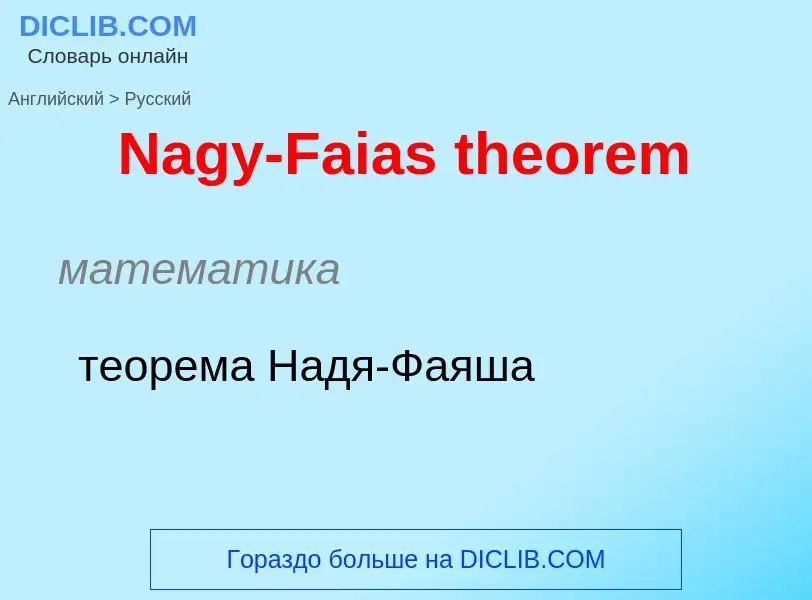Inserisci una parola o una frase in qualsiasi lingua 👆
Lingua:
Traduzione e analisi delle parole tramite l'intelligenza artificiale ChatGPT
In questa pagina puoi ottenere un'analisi dettagliata di una parola o frase, prodotta utilizzando la migliore tecnologia di intelligenza artificiale fino ad oggi:
- come viene usata la parola
- frequenza di utilizzo
- è usato più spesso nel discorso orale o scritto
- opzioni di traduzione delle parole
- esempi di utilizzo (varie frasi con traduzione)
- etimologia
Nagy-Faias theorem - traduzione in russo
WIKIMEDIA DISAMBIGUATION PAGE
Laszlo Nagy; László Nagy (disambiguation); Nagy, László; László Nagy (athlete)
Nagy-Faias theorem
математика
теорема Надя-Фаяша
divergence theorem
GENERALIZATION OF THE FUNDAMENTAL THEOREM IN VECTOR CALCULUS
Gauss' theorem; Gauss's theorem; Gauss theorem; Ostrogradsky-Gauss theorem; Ostrogradsky's theorem; Gauss's Theorem; Divergence Theorem; Gauss' divergence theorem; Ostrogradsky theorem; Gauss-Ostrogradsky theorem; Gauss Ostrogradsky theorem; Gauss–Ostrogradsky theorem
математика
теорема о дивергенции
теорема Гаусса-Остроградского
formal theorem
IN MATHEMATICS, A STATEMENT THAT HAS BEEN PROVED
Theorems; Proposition (mathematics); Theorum; Mathematical theorem; Logical theorem; Formal theorem; Theorem (logic); Mathematical proposition; Hypothesis of a theorem
математика
формальная теорема
Definizione
Надь
I
(Nagy)
Иштван (р. 23.11.1904, г. Клуж), румынский писатель. Пишет на венгерском языке. Член-корреспондент Академии СРР (1955). Рабочий-столяр, с 1931 примкнул к рабочему движению, стал коммунистом. В его ранних романах "Нет преграды" (1933), "Внуки олтенца" (1941), "Мики и его сообщники" (1942) показаны разные пути, которые приводят людей к социалистическому сознанию. Наиболее значительный роман послевоенного периода "На наивысшем напряжении" (1951) посвящен национализации промышленности в Румынии. Автор повестей для юношества: "К лесному лагерю" (1961), "Подземелье в крепости" (1967). Государственная премия СРР.
Соч. в рус. пер.: [Новеллы], в кн.: Новелла современной Румынии, М., 1962.
Лит.: Micu D., Manolescu N., Literatura română de azi, Buc., 1965.
II
(Nagy)
Лайош (5.2.1883, Апоштаг, - 28.10.1954, Будапешт), венгерский писатель. Сын крестьянина. По образованию юрист. Член компартии Венгрии с 1945. С 1908 публиковал новеллы, в которых критически изображал жизнь буржуазной Венгрии. Сочувственно встретил пролетарскую революцию 1919. С демократических позиций написаны его фельетоны, рассказы 20-30-х гг. Н. - автор фактографических романов "Кишкунхалом" (1934), "Три венгерских города" (1935), "Маска деревни" (1937), повестей "Ученик" (1945), "Деревня" (1946). Опубликовал автобиографические романы "Бунтарь" (1949). "Беглец" (1954). Премия им. Кошута (1948).
Соч.: Pincenapió, Bdpst, 1965; Válogatott karcolatok, Bdpst, 1957; в рус. пер. - Новеллы. Сост. и предисл. И. Липпаи, М., 1963.
Лит.: Кланицаи Т., Саудер И., Сабольчи М., Краткая история венгерской литературы XI-XX в., [Будапешт], 1962; Kardos P., Nagy L. élete és művei, Bdpst, 1958.
Wikipedia
László Nagy
László Nagy may refer to:
- László Nagy (Scouting) (1921–2009), Secretary General of the World Organization of the Scout Movement from 1968 to 1985
- László Nagy (figure skater) (1927–2005), figure skater
- László Nagy (politician), in the List of observers to the European Parliament for Slovakia, 2003–04
- László Nagy (poet) (1925–1978), Hungarian poet
- László Nagy (footballer) (born 1949), football (soccer) player
- László Nagy (handballer) (born 1981), Hungarian handball player
- László Nagy (canoeist), Hungarian sprint canoeist
- László Moholy-Nagy (1895–1946), Hungarian artist, designer and Bauhaus instructor
- László B. Nagy (born 1958), Hungarian politician
- László Nagy (runner) (born 1975), Hungarian long-distance runner
- László Nagy (decathlete) (born 1960), Hungarian decathlete





![universality]]) resembles the [[Mandelbrot set]]. universality]]) resembles the [[Mandelbrot set]].](https://commons.wikimedia.org/wiki/Special:FilePath/CollatzFractal.png?width=200)
